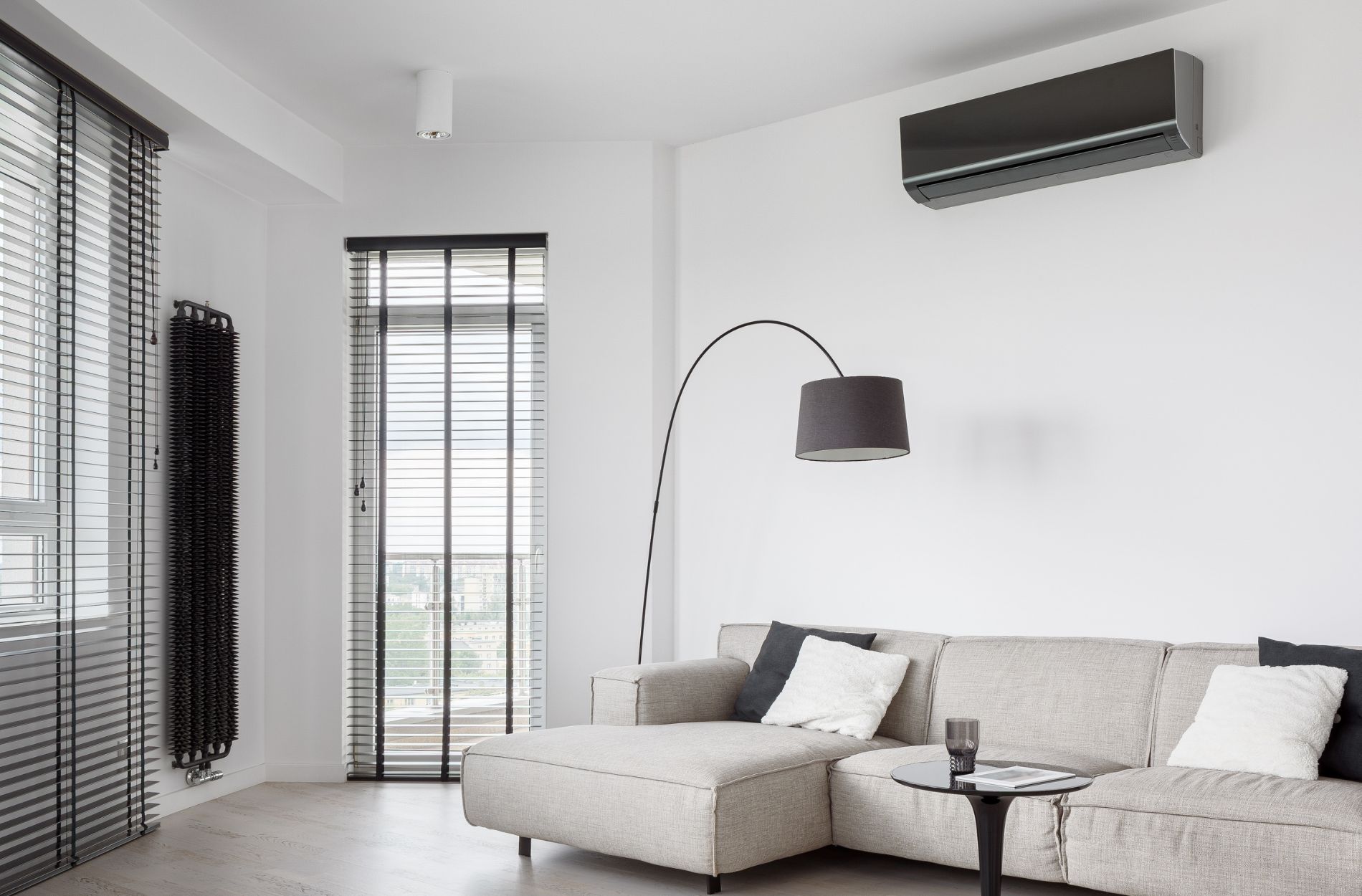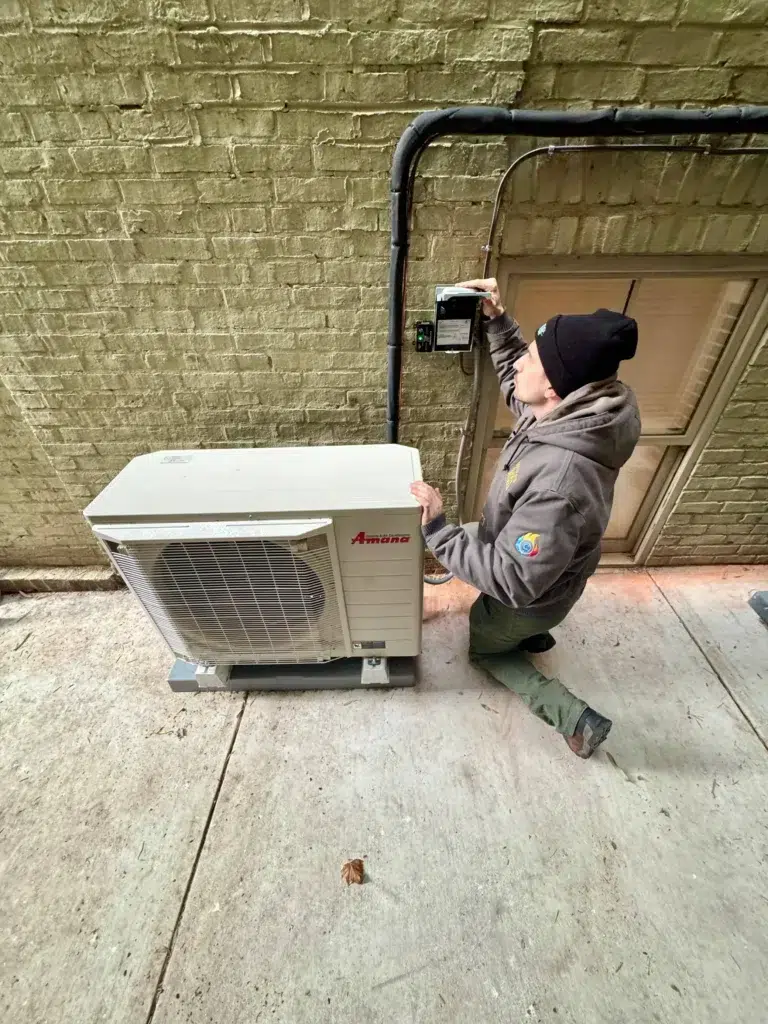A heat pump mini split system is a way to heat and cool your home without needing ducts. These systems are showing up more often in homes across Baltimore and Columbia, especially older ones where adding ductwork doesn’t make sense. They’re small, quiet, and flexible, making them a smart option for people who want room-by-room control without a full central HVAC setup.
Instead of blowing warm or cool air through long metal ducts, a heat pump mini split system delivers comfort right where you need it. This setup is becoming a favorite in basements, garages, attics, and even full homes. If you’ve ever wished one room wasn’t freezing while the others were fine, a mini split might be one reason people are fixing that problem.
What Is a Mini Split and How Does It Work?
A mini split is a type of heat pump that brings warmth in the winter and relief in the summer. It works by moving heat instead of making it from scratch. That helps it stay efficient even when the weather flips back and forth like it often does during a Baltimore fall.
The system has two main parts. Outside, there’s a unit that grabs heat from the outside air, even when it’s cold out, and sends it inside. Indoors, there is one or more wall-mounted units called heads. They’re quiet and slim, and they blow treated air straight into the room you’re sitting in.
When it gets cooler in October and November, the heat pump flips into heating mode. Instead of using fuel to create warmth, it just pulls it in from outside and pushes it indoors. In the summer, that process reverses and helps cool your space. Because they move heat rather than produce it, these systems are often more efficient and easier on your utility bill during season changes.
Where Mini Splits Work Best
Mini splits can go just about anywhere, but they really shine in places where ductwork isn’t already set up. That includes older Baltimore rowhouses, single-room additions, upstairs bedrooms, or even detached garages.
Some homeowners use them in just one or two rooms. Others install multiple indoor heads throughout the house for full coverage. Either way, you get control over each space without heating or cooling parts of the house you’re not using.
If your home has uneven temperatures between floors, or if your attic always stays chilly no matter how high you crank the heat, those are signs that a mini split might help. Maryland homes vary in age and layout, especially around Columbia and Greater Baltimore, so it makes sense that comfort needs are different room by room.
Complete Climate Services installs and services mini split systems designed to fit unique Baltimore and Columbia homes, making it simple for homeowners to add efficient heating and cooling without tearing into walls for ducts.
Benefits of Using a Heat Pump Mini Split System
There are plenty of reasons why people are switching to mini-splits. For one, each unit comes with its own remote or wall panel, which means you can set different temperatures for every room. If you like your bedroom cool at night but want the living room warm in the morning, that’s easy to do.
Mini splits run quietly and don’t take up much space. The indoor heads mount high on the wall and stay out of the way. They don’t need vents or large floor units and usually blend in better than you’d expect.
Another bonus is how they work as helpers to your central HVAC system. You don’t have to replace everything. Some folks just want better control in one spot, like finished basements or attic offices. Others use mini splits to reduce how often the main system has to run, which eases strain over time and can help with comfort during shoulder seasons like fall.
Mini split systems from Complete Climate Services come with professional installation and service plans, ensuring each unit is sized and placed for the best efficiency in your home’s layout.
Common Questions About Maintenance and Use
Keeping a mini split in good shape is pretty straightforward, but it still needs regular attention. The indoor unit has a filter that catches dust and needs to be cleaned every few weeks. That helps airflow stay strong and clean.
In fall, pay attention to the outdoor unit. Leaves, twigs, and even sticky tree seeds can clog the fan and block airflow. If you sweep the area clear from time to time, especially before heating season kicks in, it’ll last longer and work better.
Even though the maintenance is simple, anything beyond light cleaning should be handled by a pro. Strange smells, blinking lights, or poor airflow could mean something’s wrong. Having someone look things over before winter helps avoid last-minute problems when you need heat the most.
How to Know If a Mini Split Is Right for You
A mini split might be a good fit if your home has heating or cooling trouble spots. That could be a sunroom that stays way too warm or a back bedroom that never feels quite right. It’s an option for homeowners who want more comfort and don’t feel like tearing open ceilings to add ducts.
Before jumping in, think about how much space you’re trying to heat or cool. A pro can look at room size, insulation, and layout to figure out how many indoor heads you’ll need and where they should go.
Fall is the right time to think about systems like this. It gives enough time to decide and prepare before freezing winter mornings hit Baltimore. Mini splits can stand alone or work next to the system you already have. Getting the right setup often depends on how your home was built and what your comfort goals are.
Staying Comfortable Through Changing Seasons
Fall is full of temperature swings. One day it’s 75, the next you’re reaching for a hoodie. That back-and-forth means your heating system has to keep up without overdoing it. Mini splits can help during weeks like this, since they don’t need to fire up a full system to warm just one room.
As we move from fall to winter, having a setup that lets you heat certain zones while leaving others alone can make your home feel more balanced. It gives you peace of mind knowing you can get the warmth you need when you want it, without fighting with older baseboards or overworked central systems.
For homes around Baltimore and Columbia, where houses can be drafty or uneven, this type of system gives you options. You keep control from room to room and don’t have to run heat all over the house just for one space to feel right.
FAQs
How many rooms can one mini split unit heat or cool?
A single outdoor unit can usually connect to a few indoor heads. The number depends on system size and room layouts, but many setups can cover three to five rooms.
Can I set different temperatures in different rooms?
Yes. Each indoor head works on its own, so you can set warmer temps in one room and cooler ones in another. That makes it easier to keep everyone comfortable.
Do mini splits work in cold climates?
They can. Many models are built to handle cold conditions like those we get in Baltimore winters. Some work even when temps drop below freezing.
How often should mini split systems be checked by a professional?
Once a year is usually enough unless you notice issues. Seasonal checks in fall or spring help keep the system healthy before the busy months hit.
Is it normal for my mini split to run a lot during fall and winter?
Yes. Since they work by keeping temperatures steady instead of turning off and on, they may seem like they’re always running, but that’s normal and often more efficient.
Ductless Mini Splits: Efficient Home HVAC
Thinking about adding flexible heating and cooling to your home in Baltimore or Columbia? We can help you figure out what setup fits best. A well-placed system can balance rooms that always seem too hot or too chilly while leaving the rest of your house untouched.
If a heat pump mini split system is new to you, we’ll walk you through how it works and what to expect. At Complete Climate Services, we start by taking a closer look at how your home is used day to day. Call us to schedule your consultation.


